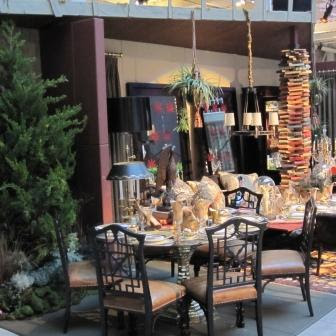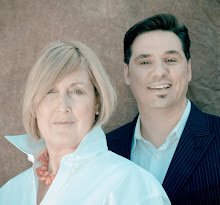
Me spending some quality time with Santa.
Everything old becomes new again at some point, isn’t that what they say? The memories, -they take you back to a time when Santa was the real deal. Often times, nostalgia gets hold of you and something inside yearns for the rebirth of an old favorite. The old City of Paris is now Neiman Marcus, but who’s to say that in 10 years, it wouldn’t make a comeback? Could we dream the same fate for the old I. Magnin which is now Ferragamo, etc., Joseph Magnin which is now Barneys, etc. etc., and the same for the original FAO Schwartz, the original Gump’s and… and a big one, the original lobby of the Westin St. Francis hotel before Barbara Barry came into town.


Union Square as it used to look. It's still the epicenter of shopping in San Francisco.
As I reflect on Christmas past, it seems that I can still recall in an instant the venture my mother and I took, every year during the Christmas holiday, when we made our annual jaunt on the train from the Peninsula to the City, specifically, to Union Square, for a big day of our annual Christmas shopping and “ladies lunch”. It was the early ‘60s when my mother wore a suit and heels, gloves and a hat to shop. She always insisted that I too done the gloves, albeit mine were white and not black kid. At that age of course, who knew it was how one dressed for a day in the big city; at the time I assumed they were meant to keep my hands clean for lunch. I still remember.

The stained glass dome from the City of Paris store, now a part of Neiman Marcus.
My mother always knew how I loved an adventure. Even then she would play right along with me, from the moment I awoke on the particular day. She would have laid out my clothes, prepared a special breakfast for she and I, and then we would set out on the train. I would beg her to tell me the schedule aloud, count by count, even days before. After arriving at the train station, we cabbed it to Market Street where always made a stop at the old Sees Candies where I was rewarded for my good behavior with a chocolate sample, handed to me from one of the ladies in white who dispersed them from her basket. The next stop was always City of Paris. For those of you old enough to remember it, it was all about the TREE. Five floors tall, at least, and it rose up to the glass domed top of the store, each floor cylindrically set. The tree was like a rocket at Cape Canaveral. The ornaments were huge, the size of basketballs, and as a child it seems like everything is real. You could stand on the top floor and look down. It was scary and fabulous all at the same time. I still remember.

A vintage shot of the Christmas tree in the City of Paris San Francisco store.
I. Magnin was always beautiful too, the true jewel in the crown on Union Square. I especially loved the boxes; even at the age of 6 - metallic gold and pale pink striped, with pale pink satin ribbons. I always felt like a princess when I walked in onto the white marble floors through the Cosmetics Department to the elevators and the mirrored walls where glass shelves hung laden with bottles and bottles of perfume. I still remember. It was at I. Magnin where we made a point of visiting the Ladies Room to freshen up before lunch. Mother let me know it was the most fabulous ladies room on the Square, with its’ dark green marble and enclosed stalls. I felt like I was in a bank. How fun was that? I still remember.

I. Magnin, a former San Francisco institution.
The next stop would be Joseph Magnin, the hip “other store” belonging to the Magnin family. Mother bought loads of things here; I mean how many mothers had paper dresses hanging in their closets? They always had a great gift department on the first floor and the huge ceramic cupcake cookie jar still has a spot on Dad’s kitchen counter. Their gift boxes were great too, but the design changed every year, the most fabulous one being the pink and maroon diamonds. I still have one.
It would be about Noon or 1ish now and we were usually famished and made the traditional stop at the little café in between the Magnins – can’t remember the name. All I remember is that the ladies wore starched pink dresses and little hats, the walls were mirrored, and it was the size of a shoebox. It was like a magic jewel box and we were crammed in there like sardines. The specialty was creamed spinach in a bowl or a sliced egg sandwich. At that age I had the egg sandwich; the creamed spinach was just not in my repertoire. I was thrilled to take a “tray” in the serve yourself line. I thought that was the greatest thing in the world. I still remember.

A vintage poster of a San Francisco flower vendor in Union Square.
After lunch was Gump’s, but the first order of business was always the flower cart at the store’s entrance where my mother ALWAYS bought me my Christmas corsage – either a small bouquet of violets or a single gardenia. It was one of the highlights. As I have come to know, Harold Hoogasion’s dad owned that cart. He was probably the man who pinned that gardenia onto my lapel. I took very good care of that flower well into the night, gingerly removing it before going to bed and putting it in a glass of water next to my bed. I still do that at Christmas. I buy a gardenia and pin it to my collar. I still remember.

Gump's, always a must for shopping in Union Square.
Gump’s meant shopping for presents for my grandparents, aunties and cousins. It was always something small enough so that mailing it wasn’t too difficult. Shopping there was a joy too as I would absorb myself in the stationery department, enamored with sealing wax and seals. I thought that was the greatest thing ever. I have a collection of seals and waxes to this day. I still remember.

The dome from the old Emporium store, now a part of a shopping mall.
At four-thirty we headed for the lobby of the St. Francis Hotel to meet my father (now the Westin St. Francis). Of course as soon as we entered, we headed immediately for the ladies room, again, another vault, ensconced in marble and matrons where once again we “freshened up” and were finally allowed to “remove” the gloves. We took a seat in the lobby as we waited for Dad. We had cocktails there in the lobby; mine of course was a Shirley Temple, then it was off to see Santa. Macy’s was the venue of choice for Santa, or sometimes even the Emporium. Macy’s had a great Santa, but Emporium had the Ferris wheel on the roof. Of course Santa was the big event of the evening with me telling Mr. Claus why I had been such a good girl and why I really deserved that bicycle. Don’t we all have a picture of ourselves sitting on Santa’s lap? I still remember.

The rooftop of the old Emporium store with rides.
The Ashfield famiy at dinner.
After dinner meant Christmas lights and we ended our big adventure every year with a drive around the city to see the lights. I still remember.
I’m well into my life now, and my mother is not with us anymore. And every year at this time, when I’m at Union Square, I still remember the Christmas shopping with my mother. It’s a favorite memory, and therein lies the magic of Christmas for me. Timeless.
Barbara Ashfield





































































